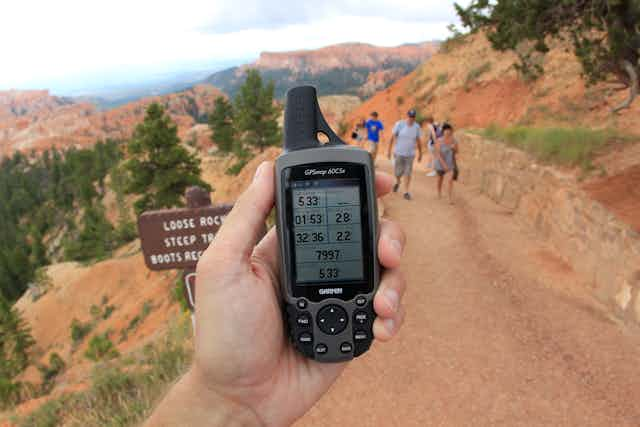It’s well known that severe space weather events – which are quite rare – can have a negative impact on our use of Global Positioning System (GPS) enabled devices. But our research, published in Geophysical Research Letters, shows that another form of space weather – which occurs on a daily basis – can cause problems for GPS too.
Knowing how to predict – or forecast – these daily space weather events is the key to protecting those people and industries who rely on GPS.
The awareness and use of the GPS has dramatically increased over the past few decades, no doubt in part due to the availability and affordability of in-car satellite navigation systems and GPS-capable smart phones.
But the use of GPS in industries in Australia, including agriculture, mining and construction, has also dramatically increased and is expected to boost the nation’s economy by up to A$13.7-billion by 2020.
This increased use and reliance on GPS in particular has actually increased our society’s vulnerability to space weather. As detailed in other online articles, space weather influences our use of many space-based technologies and assets around the world.
Disturbances in the ionosphere
A common, but much less reported, aspect of space weather is a plasma disturbance that occurs in the Earth’s ionosphere during the night-time hours, called equatorial plasma bubbles.
As the name suggests, these disturbances take place in the vicinity of the magnetic equator, such as South East Asia and Northern Australia. In some longitude sectors, such as across Africa, these plasma bubbles occur almost every night all year round.

The process responsible for the onset of these ionospheric disturbances does not involve energetic explosions on the sun’s surface, like the commonly known solar flares and coronal mass ejections. Instead, plasma bubbles are internally driven disturbances in the ionosphere that happen on a day-by-day basis.
After sunset, low electron density plasma from the lower ionosphere rises up into the high electron density plasma in the upper ionosphere, similar to a light fluid rising into a heavy fluid. This process is known as the Generalised Rayleigh-Taylor instability. The steep gradients at the edges of the bubble generates plasma waves, or turbulence.
A break in the signal
This turbulence scatters radio waves that travel through it, such as the radio signals used in satellite communications, and in the positioning, timing and navigation of GPS.
The result on the ground is that the received signal begins to randomly fluctuate in amplitude and phase (an effect called ionospheric scintillation) and becomes unrecognisable by the receiver.
This regularly causes the satellite-to-ground radio link to become completely severed. When using GPS, this only really becomes a problem when the receiver loses several satellites simultaneously, which is common at locations close to the magnetic equator because of these plasma bubbles.
But in the cases where only one satellite is being used, such as satellite communications, losing lock on the primary satellite has obvious negative implications.

A recent study investigated the potential impact of plasma bubbles in an event when radio communications failures occurred during a fatal engagement between US combat soldiers and Taliban fighters in Afghanistan.
Due to the broad radio frequency range affected by these plasma disturbances, affected applications also include other forms of satellite signals and communications; for example, satellite cellular communications and television broadcasting.
Forecasting the bubbles
Currently, there does not exist a non-experimental and openly available model or online product that informs people of potential GPS disruptions due to plasma bubbles. This is largely because there is still a lot that we do not understand about these disturbances.
Scientifically, the seasonal behaviour of plasma bubbles is relatively well understood, but why they happen on one day and not the next is still a significant and ongoing challenge in ionospheric physics.
As such, a key research goal within this particular field is to develop a reliable day-to-day space weather forecasting capability specifically for plasma bubbles, in a similar manner to the traditional “rainy day” forecasts given by meteorologists.
Our study used an artificial neural network (ANN) prediction algorithm, which is a self-learning program that is trained using a given dataset of several parameters.
In this case, those parameters were several solar wind quantities measured by the Advanced Composition Explorer spacecraft, which is located at the Lagrangian point L1 between the sun and the Earth. The algorithm used this data to predict the level of geomagnetic activity resulting from the solar wind measured.
Outputs from this prediction algorithm were combined with physics-based upper atmospheric modelling to attempt to predict the onset of these disturbances.
We were able to show up to 95% accuracy in plasma bubble prediction, potentially giving anyone affected by ionospheric scintillation a number of hours notice of potential disruptions. With such forecasts, people and industries relying on GPS will be able to plan and account for these disruptions before they occur.
Some geomagnetic activity is useful for GPS
Our results also showed that common and low-intensity geomagnetic storms, which are associated with plasma disturbances from the sun’s surface, can effectively stop the equatorial plasma bubbles from ever growing and causing disruptions on GPS.
This is important because during the peak bubble seasons (from February to April and from August to October in the Australasian region), the conditions are ripe for plasma bubble growth everyday.
We showed that geomagnetic storms change the global upper atmospheric wind system in a way that prevents the bubbles from growing at the equator during these periods, and this was well supported by our GPS observations.
These geomagnetic disturbances from the sun stop the bubbles from growing, and therefore provide opportunities for people to continue to use GPS at night-time during these peak plasma bubble seasons.
So, for those who use GPS at low-latitude locations – including in South-East Asia, the Pacific, South America and Africa – a geomagnetic disruption from the sun will actually help to stop GPS scintillation events after sunset at times of the year when scintillation events normally occur every night.

